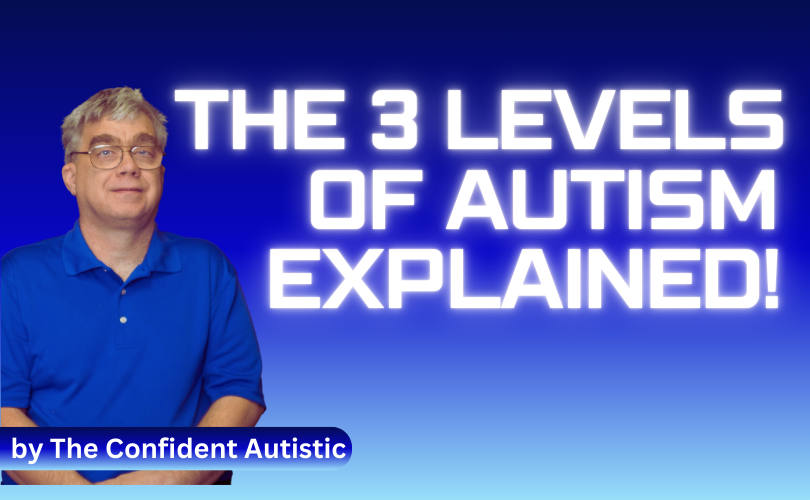The three levels of Autism that are used today help healthcare professionals including doctors, nurse practitioners, nurses, counselors, therapists, etc. provide the right level of support for us.
The brief history of the 3 levels of Autism:
Prior to the creation of today’s three levels of Autism, the previous diagnostic system included the following:
Autism Disorder
Autistic disorder was a more severe case of ASD, often defined by communication troubles, repetitive behaviors, and social challenges
Asperger’s Syndrome
Asperger’s was a milder case of ASD that may have impacted your communication or social skills.
Pervasive Developmental Disorder, Not Otherwise Specified (PDD-NOS)
PDD-NOS was a diagnosis for children who didn’t fully meet the requirements for either autistic disorder or Asperger’s.
Some medical professionals, parents, or autistic people may still use terms like Asperger’s or PDD although they have all been replaced in the 2013 publication of the fifth edition of the DSM, diagnostic and Statistical Manual of Mental Disorders. The American Psychiatric Association (APA) introduced the three levels of autism spectrum disorder (ASD) that we use today.
These three levels of ASD help specialists make more refined diagnoses, which can lead to more effective treatment plans.
Sidenote: with the release of the DSM-V, professionals were able to diagnose you with both Autism and Attention Deficit Hyperactive Disorder (ADHD) as there are many overlapping challenges both diagnoses share and up to 80% of Autistics meet the requirements for an ADHD diagnosis.
Level 1 Autism requires the least support to navigate daily life.
Level 1 autism is often considered the mildest form of autism spectrum disorder (ASD). This level was sometimes referred to as “high-functioning autism” or Asperger’s syndrome. Not only have these terms been replaced by the DSM-V, but they have fallen out of popularity. Many in our community have found the term “high functioning Autism” to be ableist term while Asperger’s, which came from Han Asperger, a man who helped the Nazi’s kill children, has become a negative term for some on the spectrum because of its history.
For those of us who are at Level 1, we may be able to live independently with minimal support. Although we may need help with social interaction, organization, and planning.
Key characteristics of Level 1 Autism include:
- Difficulty understanding social cues and nonverbal communication
- Challenges initiating and maintaining conversations
- Difficulty with flexible thinking and adapting to changes in routine
- Some sensory sensitivities to light, sound, or textures
- May struggle with executive functioning skills like planning and organization
- Can appear to be socially engaged but may miss subtle social cues
Although Level 1 Autism may be considered as a mild form of Autism by some, Level 1 Autism can still significantly impact daily life and relationships.
For those of us with Level 1 Autism, we may benefit from therapy to improve social skills and communication strategies.
The diagnosis of Level 1 Autism can be challenging as many of us who are Level 1 Autistics may be able to effectively “mask” our symptoms of Autism.
Level 2 Autism requires substantial support
Level 2 Autism is often referred to as a moderate level of Autism Spectrum Disorder (ASD). This level indicates a need for more support than Level 1 but less than Level 3 autism.
For those of us who are at Level 2, we need substantial support to help with communication (both verbal and nonverbal), coping with changes in routine, and other issues. We may also experience restricted interests and limited interests compared to those at Level 1 autism. Also, those of us with Level 2 Autism may experience repetitive behaviors.
Key characteristics of Level 2 Autism include:
- Difficulty initiating social interactions and understanding social cues
- Limited verbal communication, may speak in simple sentences or only about specific interests
- Markedly atypical nonverbal communication, like poor eye contact
- Challenges adapting to changes in routine or environment, causing distress
- Repetitive behaviors that are noticeable to others
- Narrow range of interests
Level 3 Autism requires very substantial support to meet challenges with communication and self-regulation.
Level 3 autism is the most severe form of autism spectrum disorder (ASD) and many previously referred to Level 3 Autism as “Low Functioning Autism”. However, the term “Low Functioning Autism”, as like the term “High Functioning Autism” has fallen out of popularity as many view it to be an ableist term.
Level 3 Autism is characterized by significant impairments in communication, social interaction, and behavior
For those of us who are at level three, we need very substantial support. We may have severe impairments in social communication, inflexible behavior, and limited functioning. We may also need round-the-clock support and supervision.
Autistics with Level 3 Autism require very substantial support to live fulfilling and purposeful lives. They may need support in education, employment, self-care, and other domains. They may also depend on assistive technologies, such as communication aids and sensory accommodations.
Key characteristics of Level 3 Autism include:
- Communication challenges: People with level 3 autism often have limited verbal communication or are nonverbal. They may have difficulty understanding or using spoken or written language.
- Social interaction difficulties: People with level 3 autism may have limited initiation of social interactions and may not respond to social overtures from others. They may avoid interactions with others but may interact in a limited way if they must respond.
- Behavior problems: People with level 3 autism may have repetitive behaviors, such as head-banging, biting their arms, or pulling their hair. They may also react strongly to changes and become highly distressed when asked to switch tasks.
- Sensory processing issues: People with level 3 autism may have sensory processing issues.
- Self-injury tendencies: People with level 3 autism may be at a heightened risk of self-injury.
- Daily life challenges: People with level 3 autism may face significant challenges in most aspects of life and may not be able to complete daily tasks independently.
Now it is your turn. Share your thoughts on this article.







